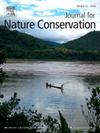Ecological restoration zoning and strategy based on ecosystem service supply and demand relationships: A case study of the Yellow River Basin
IF 2.2
3区 环境科学与生态学
Q2 BIODIVERSITY CONSERVATION
引用次数: 0
Abstract
Investigating the correlation between the matching of ecosystem services (ESs) supply and demand and the level of coordination is crucial for the systematic delineation and management of ecological restoration zones, thus ensuring ecological security and advancing regional sustainability. This study focused primarily on the Yellow River Basin, employing the InVEST model and formula calculations to evaluate ESs supply and demand. Furthermore, Bivariate Spatial Autocorrelation Analysis examined the interplay between ESs supply and demand, while an index of supply–demand coordination assessed ecological sustainability. Drawing from these analyses, ecological restoration zones were demarcated within the basin, accompanied by tailored optimization strategies that accounted for human demands, natural resource dynamics, and regional development patterns. The results indicate that: (1) In 2020, varied geographic distributions of ESs supply and demand were observed, with higher overall supply in the southern and central regions and lower supply in the north, while demand was predominantly elevated in the southeast and subdued in the northwest. (2) There was a clear imbalance between ESs supply and demand, indicating severe imbalances in the north and fundamental coordination in the south. (3) Considering the characteristics of supply–demand matching and coordination, the Yellow River Basin is divided into five ecological restoration zones for targeted management: Ecological restoration zone, Ecological protection zone, Ecological recovery zone, Ecological balance zone, and Ecological barrier zone. Differential ecological restoration pathways are proposed to provide scientific support for targeted ecological restoration practices.
求助全文
约1分钟内获得全文
求助全文
来源期刊

Journal for Nature Conservation
环境科学-生态学
CiteScore
3.70
自引率
5.00%
发文量
151
审稿时长
7.9 weeks
期刊介绍:
The Journal for Nature Conservation addresses concepts, methods and techniques for nature conservation. This international and interdisciplinary journal encourages collaboration between scientists and practitioners, including the integration of biodiversity issues with social and economic concepts. Therefore, conceptual, technical and methodological papers, as well as reviews, research papers, and short communications are welcomed from a wide range of disciplines, including theoretical ecology, landscape ecology, restoration ecology, ecological modelling, and others, provided that there is a clear connection and immediate relevance to nature conservation.
Manuscripts without any immediate conservation context, such as inventories, distribution modelling, genetic studies, animal behaviour, plant physiology, will not be considered for this journal; though such data may be useful for conservationists and managers in the future, this is outside of the current scope of the journal.
 求助内容:
求助内容: 应助结果提醒方式:
应助结果提醒方式:


